Chapter 10 Straight Lines
Short Answer Type Questions
1. Find the equation of the straight line which passes through the point $(1-2)$ and cuts off equal intercepts from axes.
Show Answer
Solution
Let the intercepts along the $X$ and $Y$-axes are $a$ and a respectively.
$\therefore$ Equation of the line is
$ \frac{x}{a}+\frac{y}{a}=1 $
Since, the point $(1,-2)$ lies on the line,
$ \therefore \frac{1}{a}-\frac{2}{a} =1 $
$ \Rightarrow \frac{1-2}{a} =1 $
$ \Rightarrow a =-1 $
On putting $a=-1$ in Eq. (i), we get
$ \Rightarrow \begin{gathered} \frac{x}{-1}+\frac{y}{-1}=1 \\ x+y=-1 \Rightarrow x+y+1=0 \end{gathered} $
2. Find the equation of the line passing through the point $(5,2)$ and perpendicular to the line joining the points $(2,3)$ and $(3,-1)$.
Show Answer
Thinking Process
First of all find the slope, using the formula $=\frac{y_2-y_1}{x_2-x_1}$. Then, slope of perpendicular line is $-\frac{1}{m}$.
Solution
Consider the given points $A(5,2), B(2,3)$ and $C(3,-1)$.
Slope of the line passing through the points $B$ and $C, m_{B C}=\frac{-1-3}{3-2}=-4$
So, the slope of required line is $\frac{1}{4}$.
Since, the equation of a line passing the point $A(5,2)$ and having slope $\frac{1}{4}$ is $y-2=\frac{1}{4}(x-5)$.
$ \begin{matrix} \Rightarrow & 4 y-8=x-5 \\ \Rightarrow & x-4 y+3=0 \end{matrix} $
3. Find the angle between the lines $y=(2-\sqrt{3})(x+5)$ and $y=(2+\sqrt{3})(x-7)$.
Show Answer
Thinking Process
If the angle between the lines having the slope $m_1$ and $m_2$ is $\theta$, then $\tan \theta=\Big|\frac{m_1-m_2}{1+m_1 m_2}\Big|$.
Use this formula to solve the above problem.
Solution
$ \begin{aligned} \text{Given lines,}\quad y & =(2-\sqrt{3})(x+5) \\ \text{Slope of this line,}\quad m_1 & =(2-\sqrt{3}) \\ \text{and}\quad y & =(2+\sqrt{3})(x-7) \\ \text{Slope of this line,}\quad m_2 & =(2+\sqrt{3}) \end{aligned} $
Let $\theta$ be the angle between lines (i) and (ii), then
$\tan \theta =\Big|\frac{m_1-m_2}{1+m_1 m_2}\Big| $
$ \Rightarrow \tan \theta =\Big|\frac{(2-\sqrt{3})-(2+\sqrt{3})}{1+(2-\sqrt{3})(2+\sqrt{3})}\Big| \Rightarrow \tan \theta=\Big|\frac{-2 \sqrt{3}}{1+4-3}\Big| $
$ \Rightarrow \tan \theta =\sqrt{3} $
$ \Rightarrow \tan \theta =\tan \pi / 3 $
$ \therefore \theta =\pi / 3=60^{\circ} $
For obtuse angle $=\pi-\pi / 3=2 \pi / 3=120^{\circ}$
Hence, the angle between the lines are $60^{\circ}$ or $120^{\circ}$.
4. Find the equation of the lines which passes through the point $(3,4)$ and cuts off intercepts from the coordinate axes such that their sum is 14.
Show Answer
Solution
Let the intercept along the axes be $a$ and $b$.
Given, $\quad a+b=14 \Rightarrow b=14-a$
Now, the equation of line is $\frac{x}{a}+\frac{y}{b}=1$.
$\Rightarrow \quad \frac{x}{a}+\frac{y}{14-a}=1$
Since, the point $(3,4)$ lies on the line.
$ \therefore \frac{3}{a}+\frac{4}{14-a} =1 $
$ \Rightarrow \frac{42-3 a+4 a}{a(14-a)} =1 \Rightarrow 42+a=14 a-a^{2} $
$ \Rightarrow a(a-7)-6(a-7) =0 \Rightarrow(a-7)(a-6)=0 $
$ \Rightarrow a-7 =0 \text { or } a-6=0 $
$ \Rightarrow a =7 \text { or } a=6 $
$\text { When } a =7, \text { then } b=7 $
$\text { When } a =6, \text { then } b=8$
$\therefore$ The equation of line, when $a=7$ and $b=7$ is
$ \frac{x}{7}+\frac{y}{7}=1 \Rightarrow x+y=7 $
So, the equation of line, when $a=6$ and $b=8$ is $\frac{x}{6}+\frac{y}{8}=1$
5. Find the points on the line $x+y=4$ which lie at a unit distance from the line $4 x+3 y=10$.
Show Answer
Thinking Process
The perpendicular distance of a point $(x_1, y_1)$ from the line $A x+B y+C=0$, is $d^{\prime}$, where $d=\Big|\frac{A x_1+B y_1+C}{\sqrt{A^{2}+B^{2}}}\Big|$.
Solution
Let the required point be $(h, k)$ and point $(h, k)$ lies on the line $x+y=4$ i.e., $\quad h+k=4$
The distance of the point $(h, k)$ from the line $4 x+3 y=10$ is
Taking positive sign,
$ \begin{aligned} \Big|\frac{4 h+3 k-10}{\sqrt{16+9}} \Big|& =1 \\ 4 h+3 k-10 & = \pm 5 \\ 4 h+3 k & =15 \end{aligned} $
From Eq. (i) $h=4-k$ put in Eq. (ii), we get
$ \begin{aligned} & \Rightarrow 4(4-k)+3 k=15 \\ & \Rightarrow 16-4 k+3 k=15 \\ & \text { On putting } k=1 \text { in Eq. (i), we get } \end{aligned} $
So, the point is $(3,1)$.
Taking negative sign,
$ \begin{aligned} & 4 h+3 k-10 =-5 \\ \Rightarrow & 4(4-k)+3 k =5 \\ \Rightarrow & 16-4 k+3 k =5 \\ \therefore & -k=5-16 =-11 \\ \therefore & k =11 \end{aligned} $
On putting $k=11 in \mathrm{Eq.}$ (i), we get
$ h+11=4 \Rightarrow h=-7 $
Hence, the required points are $(3,1)$ and $(-7,11)$.
6. Show that the tangent of an angle between the lines $\frac{x}{a}+\frac{y}{b}=1$ and $\frac{x}{a}-\frac{y}{b}=1$ is $\frac{2 a b}{a^{2}-b^{2}}$.
Show Answer
Solution
Given equation of lines are
$ \frac{x}{a}+\frac{y}{b} =1 $
$ \text { and } \text { Slope, } m_1 =-\frac{b}{a} $
$ \therefore \frac{x}{a}-\frac{y}{b} =1 $
$ \text { Slope, } m_2 =\frac{b}{a} $
Let $\theta$ be the angle between the given lines, then
$ \begin{aligned} & \tan \theta=\Big|\frac{m_1-m_2}{1+m_1 m_2}\Big| \Rightarrow \tan \theta=\Big|\frac{-\frac{b}{a}-\frac{b}{a}}{1+(\frac{-b}{a})(-\frac{b}{a})}\Big| \\ & \Rightarrow \quad \tan \theta=\Big|\frac{\frac{-2 b}{a}}{\frac{a^{2}-b^{2}}{a^{2}}}\Big| \Rightarrow \tan \theta=\frac{2 a b}{a^{2}-b^{2}} \end{aligned} $
Hence proved.
7. Find the equation of lines passing through $(1,2)$ and making angle $30^{\circ}$ with $Y$-axis.
Show Answer
Thinking Process
Equation of a line passing through the point $(x_1, y_1)$ and having slope $m$ is $y-y_1=m(x-x_1)$.
Solution
Given that, angle with $Y$-axis $=30^{\circ}$
and angle with $X$-axis $=60^{\circ}$
$\therefore$ Slope of the line, $m=\tan 60^{\circ}=\sqrt{3}$
So, the equation of a line passing through $(1,2)$ and having slope $\sqrt{3}$, is
$ \begin{matrix} \Rightarrow & y-2 =\sqrt{3}(x-1) \\ \Rightarrow & y-2 =\sqrt{3} x-\sqrt{3} \\ \Rightarrow & y-\sqrt{3} x-2+\sqrt{3} =0 \end{matrix} $
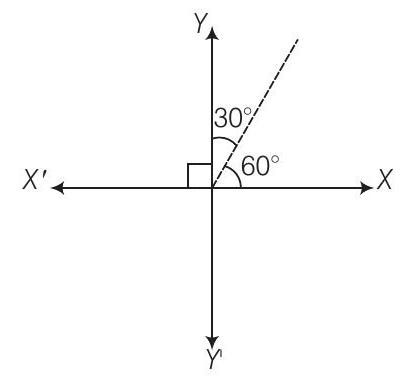
8. Find the equation of the line passing through the point of intersection of $2 x+y=5$ and $x+3 y+8=0$ and parallel to the line $3 x+4 y=7$.
Show Answer
Thinking Process
First of all solve the given equation of lines to get the point of intersection. Then, if a line having slope $m_1$ is parallel to another line having slope, $m_2$, then $m_1=m_2$. Now, use the formula i.e., equation of a line passing through the point $(x_1, y_1)$ with slope $m$ is $y-y_1=m(x-x_1)$
Solution
Given equation of lines
$ \begin{aligned} 2 x+y & =5 \\ x+3 y & =-8 \\ y & =5-2 x \end{aligned} $
From Eq. (i),
Now, put the value of $y$ in Eq. (ii), we get
$ x+3(5-2 x) =-8 $
$ \Rightarrow x+15-6 x =-8 $
$ \Rightarrow -5 x =-23 \Rightarrow x=\frac{23}{5} $
Now, $x=\frac{23}{5}$ put in Eq. (i), we get
$ y=5-\frac{46}{5}=\frac{25-46}{5}=\frac{-21}{5} $
Since, the required line is parallel to the line $3 x+4 y=7$. So, slope of the line is $m=\frac{-3}{4}$.
So, the equation of the line passing through the point $(\frac{23}{5}), (\frac{-21}{5})$ having slope $(\frac{-3}{4})$ is
$ y+\frac{21}{5} =\frac{-3}{4} x\Big(-\frac{23}{5}\Big) $
$ \Rightarrow 4 y+\frac{84}{5} =-3 x+\frac{69}{5} $
$ \Rightarrow 3 x+4 y =\frac{84-69}{5} \Rightarrow 3 x+4 y+\frac{15}{5}=0 $
$ \Rightarrow 3 x+4 y+3 =0 $
9. For what values of $a$ and $b$ the intercepts cut off on the coordinate axes by the line $a x+b y+8=0$ are equal in length but opposite in signs to those cut off by the line $2 x-3 y+6=0$ on the axes?
Show Answer
Solution
Given equation of line
$ \begin{matrix} a x+b y+8=0 \\ \\ \Rightarrow\frac{x}{\frac{-8}{a}}+\frac{y}{\frac{-8}{b}}=1 \end{matrix} $
So, the intercepts are $\frac{-8}{a}$ and $\frac{-8}{b}$.
and another given equation of line is $2 x-3 y+6=0$.
$\Rightarrow \quad \frac{x}{-3}+\frac{y}{2}=1$
So, the intercepts are -3 and 2 .
According to the question,
$ \begin{aligned} & \frac{-8}{a} =3 \text { and } \frac{-8}{b}=-2 \\ \therefore & a =-\frac{8}{3}, b=4 \end{aligned} $
10. If the intercept of a line between the coordinate axes is divided by the point $(-5,4)$ in the ratio $1: 2$, then find the equation of the line.
Show Answer
Thinking Process
The coordinates of a point which divides the join of $(x_1, y_1)$ and $(x_2, y_2)$ in the ratio $m_1: m_2$ internally is $\Big(\frac{m_1 x_2+m_2 x_1}{m_1+m_2}, \frac{m_1 y_2+m_2 y_1}{m_1+m_2}\Big)$.
Solution
Let intercept of a line are $(h, k)$.
The coordinates of $A$ and $B$ are $(h, 0)$ and $(0, k)$ respectively.
$ \begin{aligned} & -5=\frac{1 \times 0+2 \times h}{1+2} \\ & \therefore \quad-5=\frac{2 h}{3} \Rightarrow+h=-\frac{15}{2} \\ & \text { and } \quad 4=\frac{1 \cdot k+0 \cdot 2}{1+2} \\ & \Rightarrow \quad k=12 \\ & \therefore \quad A=(-\frac{15}{2}, 0) \text { and } B=(0,12) \end{aligned} $
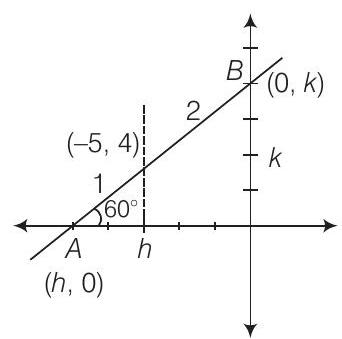
Hence, the equation of a line $A B$ is
$ \begin{aligned} & & y-0=\frac{12-0}{0+15 / 2} \Big(x+\frac{15}{2}\Big) \\ \Rightarrow & y =\frac{12 \cdot 2}{15} \Big(x+\frac{15}{2}\Big) \\ \Rightarrow & 5 y =8 x+60 \Rightarrow 8 x-5 y+60=0 \end{aligned} $
11. Find the equation of a straight line on which length of perpendicular from the origin is four units and the line makes an angle of $120^{\circ}$ with the positive direction of $X$-axis.
Show Answer
Thinking Process
The equation of the line having normal distance Pfrom the origin and angle $\alpha$ which the normal makes with the positive direction of X-axis is $x \cos \alpha+y \sin \alpha=p$. Use this formula to solve the above problem.
Solution
Given that, $O C=P=4$ units
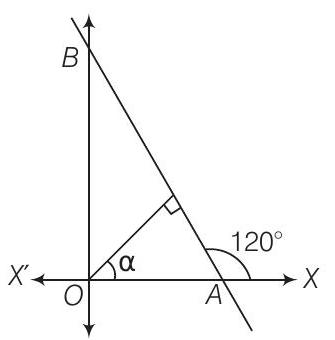
$ \begin{aligned} & \angle B A X=120^{\circ} \\ & \text { Let } \quad \angle C O A=\alpha, \angle O C A=90^{\circ} \\ & \because \quad \angle B A X=\angle C O A+\angle O C A \quad \text { [exterior angle property] } \\ & \Rightarrow \quad 120^{\circ}=\alpha+90^{\circ} \\ & \therefore \quad \alpha=30^{\circ} \\ & \text{ Now, the equation of required line is} \\ & x \cos 30^{\circ}+y \sin 30^{\circ}=4 \\ & \Rightarrow \quad x \cdot \frac{\sqrt{3}}{2}+y \cdot \frac{1}{2}=4 \\ & \Rightarrow \sqrt 3 x+y=8 \end{aligned} $
12. Find the equation of one of the sides of an isosceles right angled triangle whose hypotenuse is given by $3 x+4 y=4$ and the opposite vertex of the hypotenuse is $(2,2)$.
Show Answer
Solution
Let slope of line $A C$ be $m$ and slope of line $B C$ is $\frac{-3}{4}$ and let angle between line $A C$ and $B C$ be $\theta$.
$ \therefore \tan \theta=\Big|\frac{m+\frac{3}{4}}{1-\frac{3 m}{4}}\Big| \Rightarrow \tan 45^{\circ} = \pm \Big[\frac{m+\frac{3}{4}}{1-\frac{3 m}{4}} \Big]$
$ \text { Taking positive sign, } 1 =\frac{m+\frac{3}{4}}{1-\frac{3 m}{4}} $
$ \Rightarrow m+\frac{3}{4} =1-\frac{3 m}{4}$
$ \Rightarrow m+\frac{3 m}{4} =1-\frac{3}{4} $
$ \Rightarrow \frac{7 m}{4} =\frac{1}{4} \Rightarrow m=\frac{1}{7} $
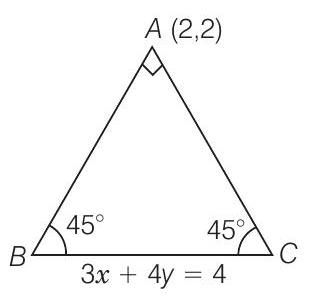
Taking negative sign,
$ \begin{aligned} & \quad 1=-\Big(\frac{m+\frac{3}{4}}{1-\frac{3 m}{4}}\Big) \Rightarrow 1-\frac{3 m}{4}=-m-\frac{3}{4} \\ & \Rightarrow \quad m-\frac{3 m}{4}=-1-\frac{3}{4} \\ & \Rightarrow \quad \frac{m}{4}=\frac{-7}{4} \Rightarrow m=-7 \\ & \begin{matrix} \therefore \text { Equation of side } A C \text { having slope } (\frac{1}{7}) \text { is } \end{matrix} \\ & \quad y-2=\frac{1}{7}(x-2) \\ & \Rightarrow \quad 7 y-14=x-2 \\ & \text { and equation of side } A B \text { having slope }(-7) \text { is } \\ & \Rightarrow \quad y-2=-7(x-2) \\ & \Rightarrow \quad y-2=-7 x+14 \\ & \Rightarrow \quad 7 x+y-16=0 \end{aligned} $
Long Answer Type Questions
13. If the equation of the base of an equilateral triangle is $x+y=2$ and the vertex is $(2,-1)$, then find the length of the side of the triangle.
Show Answer
Thinking Process
Find the length of perpendicular ( $p$ ) from $(2,-1)$ to the line and use $p=l \sin 60^{\circ}$, where $l$ is the length of the side of the triangle.
Solution
Given that, equilateral $\triangle A B C$ having equation of base is $x+y=2$.
$\ln \triangle A B D$,
$ \begin{aligned} \sin 60^{\circ} & =\frac{A D}{A B} \\ A D & =A B \sin 60^{\circ}=A B \frac{\sqrt{3}}{2} \\ \Rightarrow A D & =A B \frac{\sqrt{3}}{2} \end{aligned} $
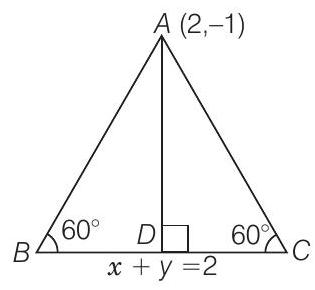
Now, the length of perpendicular from $(2,-1)$ to the line $x+y=2$ is given by
$AD = \Big| \frac{2+(-1)-2}{\sqrt {1^{2}+1^{2}}}\Big| = \frac{1}{\sqrt 2}$
From Eq. (i),
$ \begin{aligned} & \frac{1}{\sqrt{2}}=A B \frac{\sqrt{3}}{2} \\ & A B=\sqrt{\frac{2}{3}} \end{aligned} $
14. A variable line passes through a fixed point $P$. The algebraic sum of the perpendiculars drawn from the points $(2,0),(0,2)$ and $(1,1)$ on the line is zero. Find the coordinates of the point $P$.
Show Answer
Thinking Process
Let the slope of the line be $m$. Then, the equation of the line passing through the fixed point $P(x_1, y_1)$ is $y-y_1=m(x-x_1)$. Taking the algebraic sum of perpendicular distances equal to zero, we get $y_1-1=m(x_1-1)$. Thus, $(x_1, y_1)$ is $(1,1)$.
Solution
Let slope of the line be $m$ and the coordinates of fixed point $P$ are $(x_1, y_1)$.
$\therefore \quad$ Equation of line is $y-y_1=m(x-x_1)$
Since, the given points are $A(2,0), B(0,2)$ and $C(1,1)$.
Now, perpendicular distance from $A$, is
$ \frac{0-y_1-m(2-x_1)}{\sqrt{1+m^{2}}} $
Perpendicular distance from $B$, is
$ \frac{2-y_1-m(0-x_1)}{\sqrt{1+m^{2}}} $
Perpendicular distance from $C$, is
$ \frac{1-y_1-m(1-x_1)}{\sqrt{1+m^{2}}}$
$ \text { Now, } \frac{-y_1-2 m+m x_1+2-y_1+m x_1+1-y_1-m+m x_1}{\sqrt{1+m^{2}}}=0 $
$ \Rightarrow -3 y_1-3 m+3 m x_1+3=0 $
$ \Rightarrow -y_1-m+m x_1+1=0 $
Since, $(1,1)$ lies on this line. So, the point $P$ is $(1,1)$.
15. In what direction should a line be drawn through the point $(1,2)$, so that its point of intersection with the line $x+y=4$ is at a distance $\frac{\sqrt{6}}{3}$ from the given point?
Show Answer
Solution
Let slope of the line be $m$. As, the line passes through the point $A(1,2)$.
$\therefore \quad$ Equation of line is $y-2=m(x-1)$
$ \begin{aligned} m x-y+2-m & =0 \\ x+v-4 & =0 \end{aligned} $
and
$ \frac{x}{(4-2+m)}=\frac{y}{2-m+4 m}=\frac{1}{1+m} $
$ \Rightarrow \quad \frac{x}{2+m}=\frac{y}{3 m+2}=\frac{1}{1+m} $
$\Rightarrow \quad x=\frac{2+m}{1+m}$
$ y=\frac{3 m+2}{1+m} $
So, the point of intersection is $B \Big(\frac{m+2}{m+1}, \frac{3 m+2}{m+1}\Big)$.
$ \begin{aligned} & \text { Now, } \\ & A B^{2}=\Big(\frac{m+2}{m+1}-1\Big)^{2}+\Big(\frac{3 m+2}{m+1}-2\Big)^{2} \\ & \because \quad A B=\frac{\sqrt{6}}{3} \\ & \therefore \quad \Big(\frac{m+2-m-1}{m+1}\Big)^{2}+\Big(\frac{3 m+2-2 m-2}{m+1}\Big)^{2}=\frac{6}{9} \\ & \Rightarrow \quad \Big(\frac{1}{m+1}\Big)^{2}+\Big(\frac{m}{m+1}\Big)^{2}=\frac{6}{9} \\ & \Rightarrow \quad \frac{1+m^{2}}{(1+m)^{2}}=\frac{6}{9} \\ & \Rightarrow \quad \frac{1+m^{2}}{1+m^{2}+2 m}=\frac{6}{9} \\ & \Rightarrow \quad 9+9 m^{2}=6+6 m^{2}+12 m \\ & \Rightarrow \quad 3 m^{2}-12 m+3=0 \\ & \Rightarrow \quad m^{2}-4 m+1=0 \\ & \therefore \quad m=\frac{4 \pm \sqrt{16-4}}{2} \\ & =2 \pm \sqrt{3} \\ & =2+\sqrt{3} \text { or } 2-\sqrt{3} \\ & \theta=75^{\circ} \text { or } 15^{\circ} \end{aligned} $
16. A straight line moves so that the sum of the reciprocals of its intercepts made on axes is constant. Show that the line passes through a fixed point.
Show Answer
Thinking Process
If a line is $\frac{x}{a}+\frac{y}{b}=1$, where $\frac{1}{a}+\frac{1}{b}=$ constant $=\frac{1}{k}$ (say). This implies that $\frac{k}{a}+\frac{k}{b}=1 \Rightarrow$ line passes through the fixed point $(k, k)$.
Solution
Since, the intercept form of a line is $\frac{x}{a}+\frac{y}{b}=1$.
Given that,
$\because \frac{1}{a}+\frac{1}{b}=\text { constant }$
$\Rightarrow \frac{1}{a}+\frac{1}{b}=\frac{1}{k}$
$\Rightarrow \frac{k}{a}+\frac{k}{b}=1$
So, $(k, k)$ lies on $\frac{x}{a}+\frac{y}{b}=1$.
Hence, the line passes through the fixed point.
17. Find the equation of the line which passes through the point $(-4,3)$ and the portion of the line intercepted between the axes is divided internally in the ratio $5: 3$ by this point.
Show Answer
Thinking Process
If the point $(h, k)$ divides the join of $A(x_1, y_2)$ and $B(x_2, y_2)$ internally, in the ratio $m_1: m_2$. Then, first of all find the coordinates of $A$ and $B$ using section formula for internal division i.e., $h=\frac{m_1 x_2+m_2 x_1}{m_1+m_2}, k=\frac{m_1 y_2+m_2 y_1}{m_1+m_2}$. Then, find the equation of required line.
Solution
Since, the line intersects $X$ and $Y$-axes respectively at $A(x, 0)$ and $B(0, y)$.
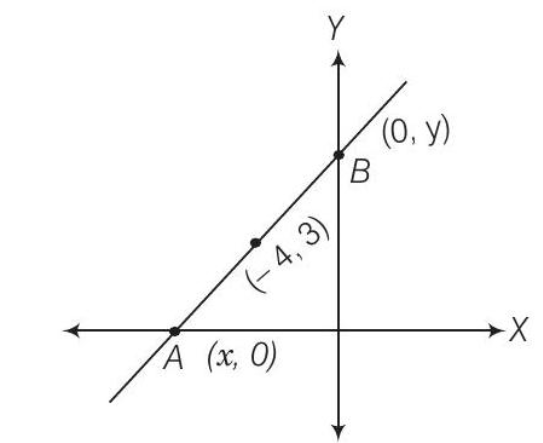
$\begin{aligned}-4 & =\frac{5 \times 0+3 x}{5+3} \\ \Rightarrow -4 & =\frac{3 x}{8} \Rightarrow x=\frac{-32}{3} \\ \text{and}\quad 3 & =\frac{5 \cdot y+3 \cdot 0}{5+3} \\ \Rightarrow 3 & =\frac{5 y}{8} \Rightarrow y=\frac{24}{5}\end{aligned}$
Since, the intercept on the $X$ and $Y$-axes respectively are $a=\frac{-32}{3}$ and $b=\frac{24}{5}$.
$\therefore$ Equation of required line is
$ \begin{aligned} & \frac{x}{-32 / 3}+\frac{y}{24 / 5} & =1 \\ \Rightarrow & \frac{-3 x}{32}+\frac{5 y}{24} & =1 \\ \Rightarrow & 9 x-20 y+96 & =0 \end{aligned} $
18. Find the equations of the lines through the point of intersection of the lines $x-y+1=0$ and $2 x-3 y+5=0$ and whose distance from the point $(3,2)$ is $\frac{7}{5}$.
Show Answer
Solution
Given equation of lines
$ \begin{aligned} x-y+1 & =0 \\ 2 x-3 y+5 & =0 \\ x & =y-1 \end{aligned} $
Now, put the value of $x$ in Eq. (ii), we get
$ \begin{matrix} \Rightarrow & 2(y-1)-3 y+5 =0 \\ \Rightarrow & 2 y-2-3 y+5 =0 \\ y=3 \text { put in Eq. (i), we get } & 3-y=0 \Rightarrow y =3 \\ & x =2 \end{matrix} $
Since, the point of intersection is $(2,3)$.
Let slope of the required line be $m$.
$\therefore$ Equation of line is
$ y-3=m(x-2) $
$\Rightarrow$ $ m x-y+3-2 m=0 $
Since, the distance from $(3,2)$ to line (iii) is $\frac{7}{5}$.
$ \begin{aligned} & \therefore \quad \frac{7}{5}=\Big|\frac{3 m-2+3-2 m}{\sqrt{1+m^{2}}}\Big| \\ & \Rightarrow \quad \frac{49}{25}=\frac{(m+1)^{2}}{1+m^{2}} \\ & \Rightarrow \quad 49+49 m^{2}=25(m^{2}+2 m+1) \\ & \Rightarrow \quad 49+49 m^{2}=25 m^{2}+50 m+25 \\ & \Rightarrow \quad 24 m^{2}-50 m+24=0 \\ & \Rightarrow \quad 12 m^{2}-25 m+12=0 \\ & \therefore \quad m=\frac{25 \pm \sqrt{625-4 \cdot 12 \cdot 12}}{24} \\ & =\frac{25 \pm \sqrt{49}}{24}=\frac{25 \pm 7}{24}=\frac{32}{24} \text { or } \frac{18}{24}=\frac{4}{3} \text { or } \frac{3}{4} \\ & \therefore \text { First equation of a line is } \quad y-3=\frac{4}{3}(x-2) \\ & \begin{matrix} \Rightarrow & 3 y-9=4 x-8 \end{matrix} \\ & \Rightarrow \quad 4 x-3 y+1=0 \\ & \text { and second equation of line is } \quad y-3=\frac{3}{4}(x-2) \\ & \Rightarrow \\ & 4 y-12=3 x-6 \\ & \Rightarrow \\ & 3 x-4 y+6=0 \end{aligned} $
19. If the sum of the distance of a moving point in a plane from the axes is 1 , then find the locus of the point.
Show Answer
Thinking Process
Given that $|x|+|y|=1$, which gives four sides of a square.
Solution
Let the coordinates of moving point $P$ be $(x, y)$. Given that, the sum of distances of this point in a plane from the axes is 1 .
$ \begin{matrix} \therefore & |x|+|y|=1 \\ \Rightarrow & \pm x \pm y=1 \\ \Rightarrow & x+y=1 \\ \Rightarrow & -x-y=1 \\ \Rightarrow & -x+y=1 \\ \Rightarrow & x-y=1 \end{matrix} $
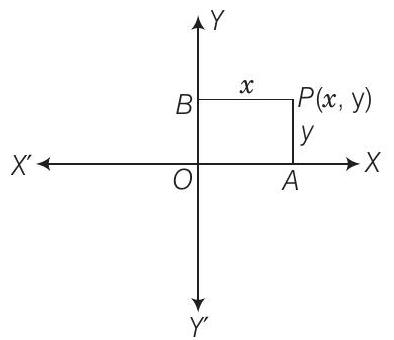
So, these equations give us locus of the point which is a square.
20. $P_1$ and $P_2$ are points on either of the two lines $y-\sqrt{3}|x|=2$ at a distance of 5 units from their point of intersection. Find the coordinates of the foot of perpendiculars drawn from $P_1, P_2$ on the bisector of the angle between the given lines.
Show Answer
Thinking Process
Lines are $y=\sqrt{3} x+2$ and $y=-\sqrt{3} x+2$ according as $x \geq 0$ or $x<0$. Y-axis is the bisector of the angles between the lines. $P_1, P_2$ are the points on these lines at a distance of 5 units from the point of intersection of these lines which have a point on $Y$-axis as common foot of perpendiculars drawn from these points. The $y$-coordinate of the foot of the perpendiculars is given by $2+5 \cos 30^{\circ}$.
Solution
Given equation of lines are
$ \begin{aligned} y-\sqrt{3} x & =2 \\ y+\sqrt{3} x & =2 \\ y & =\sqrt{3} x+2 \\ y & =-\sqrt{3} x+2 \\ \sqrt{3} x+2 & =-\sqrt{3} x+2 \end{aligned} $
$ [\because x \geq 0] $
$ \Rightarrow \quad 2 \sqrt{3} x=0 \Rightarrow x=0 $
On putting $x=0$ in Eq. (i), we get
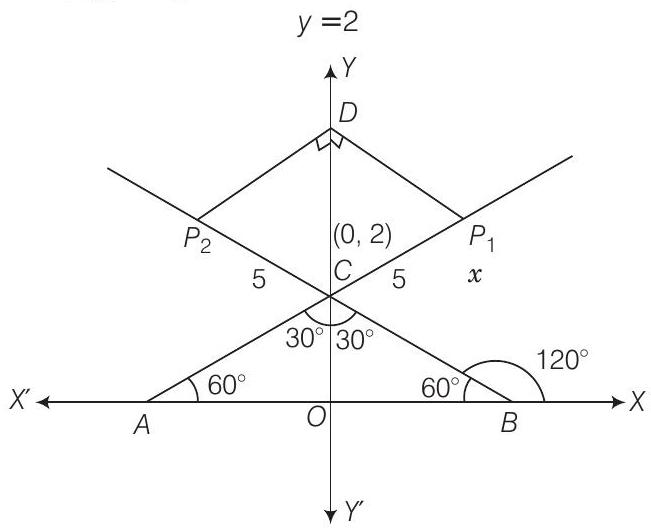
So, the point of intersection of line (i) and (ii) is $(0,2)$.
Here,
$ \begin{aligned} O C & =2 \\ \text{In $\triangle D E C$}\quad \frac{C D}{C E} & =\cos 30^{\circ} \\ C D =5 \cos 30 \\ & =5 \cdot \frac{\sqrt{3}}{2} \end{aligned} $
$ \begin{aligned} \therefore & C D =5 \cos 30^{\circ} \\ & =5 \cdot \frac{\sqrt{3}}{2} \\ \Rightarrow & O D =O C+C D=2+5 \frac{\sqrt{3}}{2} \end{aligned} $
So, the coordinates of the foot of perpendiculars are $\Big(0,2+\frac{5 \sqrt{3}}{2}\Big)$.
21. If $p$ is the length of perpendicular from the origin on the line $\frac{x}{a}+\frac{y}{b}=1$ and $a^{2}, p^{2}$ and $b^{2}$ are in AP, the show that $a^{4}+b^{4}=0$.
Show Answer
Solution
Given equation of line is,
$ \frac{x}{a}+\frac{y}{b}=1 $
Perpendicular length from the origin on the line (i) is given by $p$
$ \begin{matrix} \text { i.e., } & p=\frac{1}{\sqrt{\frac{1}{a^{2}}+\frac{1}{b^{2}}}}=\frac{a b}{\sqrt{a^{2}+b^{2}}} \\ \therefore \quad p^{2}=\frac{a^{2} b^{2}}{a^{2}+b^{2}} \end{matrix} $
Given that, $a^{2}, p^{2}$ and $b^{2}$ are in AP.
$ \begin{matrix} \therefore & 2 p^{2}=a^{2}+b^{2} \\ \Rightarrow & \frac{2 a^{2} b^{2}}{a^{2}+b^{2}}=a^{2}+b^{2} \\ \Rightarrow & 2 a^{2} b^{2}=(a^{2}+b^{2})^{2} \\ \Rightarrow & 2 a^{2}+b^{2}=a^{4}+b^{4}+2 a^{2} b^{2} \\ \Rightarrow & a^{4}+b^{4}=0 \end{matrix} $
Objective Type Questions
22. A line cutting off intercept -3 from the $Y$-axis and the tangent at angle to the $X$-axis is $\frac{3}{5}$, its equation is
(a) $5 y-3 x+15=0$
(b) $3 y-5 x+15=0$
(c) $5 y-3 x-15=0$
(d) None of the above
Show Answer
Solution
(a) Given that,
$ c=-3 \text { and } m=\frac{3}{5} $
$\therefore$ Equation of the line is $y=m x+c$
$ y =\frac{3}{5} x-3$
$ \Rightarrow 5 y =3 x-15 $
$ \Rightarrow 5 y-3 x+15 =0 $
23. Slope of a line which cuts off intercepts of equal lengths on the axes is
(a) -1
(b) 0
(c) 2
(d) $\sqrt{3}$
Show Answer
Solution
(a) Let equation of line be
$ \begin{aligned} & \frac{x}{a}+\frac{y}{a}=1 \\ & x+y=a \end{aligned} $
$ \begin{aligned} \Rightarrow & & x+y & =a \\ \Rightarrow & & y & =-x+a \\ \therefore & & \text { Required slope } & =-1 \end{aligned} $
24. The equation of the straight line passing through the point $(3,2)$ and perpendicular to the line $y=x$ is
(a) $x-y=5$
(b) $x+y=5$
(c) $x+y=1$
(d) $x-y=1$
Show Answer
Solution
(b) Since, line passes through the point $(3,2)$ and perpendicular to the line $y=x$.
$\because$ Slope $(m)=-1 \quad$ [since, line is perpendicular to the line $y=x]$
$\therefore \quad$ Equation of line which passes through $(3,2)$ is
$ \begin{aligned} & y-2=-1(x-3) \\ & y-2=-x+3 \end{aligned} $
$ \Rightarrow x+y=5 $
25. The equation of the line passing through the point $(1,2)$ and perpendicular to the line $x+y+1=0$ is
(a) $y-x+1=0$
(b) $y-x-1=0$
(c) $y-x+2=0$
(d) $y-x-2=0$
Show Answer
Solution
(b) Given point is $(1,2)$ and slope of the required line is 1 .
$\because x+y+1=0 \Rightarrow y=-x-1 \Rightarrow m_1=-11$
$\therefore$ slope of the line $=\frac{-1}{-1}=1$
$\therefore$ Equation of required line is
$ y-2 =1(x-1) $
$ \Rightarrow y-2 =x-1 $
$ \Rightarrow y-x-1 =0 $
26. The tangent of angle between the lines whose intercepts on the axes are $a,-b$ and $b,-a$ respectively, is
(a) $\frac{a^{2}-b^{2}}{a b}$
(b) $\frac{b^{2}-a^{2}}{2}$
(c) $\frac{b^{2}-a^{2}}{2 a b}$
(d) None of these
Show Answer
Solution
(c) Since, intercepts on the axes are $a,-b$ then equation of the line is $\frac{x}{a}-\frac{y}{b}=1$.
$ \begin{matrix} \Rightarrow & \frac{y}{b}=\frac{x}{a}-1 \\ \Rightarrow & y=\frac{b x}{a}-b \end{matrix} $
So, the lope of this line i.e., $m_1=\frac{b}{a}$.
Also, for intercepts on the axes as $b$ and $-a$, then equation of the line is
$ \Rightarrow \quad \begin{aligned} \frac{x}{b}-\frac{y}{a} & =1 \\ \frac{y}{a} & =\frac{x}{b}-1 \Rightarrow y=\frac{a}{b} x-a \end{aligned} $
and slope of this line i.e., $m_2=\frac{a}{b}$
$ \therefore \quad \tan \theta=\frac{\frac{b}{a}-\frac{a}{b}}{1+\frac{a}{b} \cdot \frac{b}{a}}=\frac{\frac{b^{2}-a^{2}}{a b}}{2}=\frac{b^{2}-a^{2}}{2 a b} $
27. If the line $\frac{x}{a}+\frac{y}{b}=1$ passes through the points $(2,-3)$ and $(4,-5)$, then $(a, b)$ is
(a) $(1,1)$
(b) $(-1,1)$
(c) $(1,-1)$
(d) $(-1,-1)$
Show Answer
Solution
(d) Given, line is $\frac{x}{a}+\frac{y}{b}=1$
Since, the points $(2,-3)$ and $(4,-5)$ lies on this line.
$ \begin{matrix} \therefore & \frac{2}{a}-\frac{3}{b}=1 \\ \\ \text { and } & \frac{4}{a}-\frac{5}{b}=1 \end{matrix} $
On multiplying by 2 in Eq. (ii) and then subtracting Eq. (iii) from Eq. (ii), we get
$ -\frac{6}{b}+\frac{5}{b} =1 $
$ \Rightarrow \frac{-1}{b} =1 $
$ \therefore b =-1 $
On putting $b=-1$ in Eq. (ii), we get
$ \begin{aligned} \Rightarrow & \frac{2}{a}+3 =1 \\ \therefore & \frac{2}{a} =-2 \Rightarrow a=-1 \\ & (a, b) =(-1,-1) \end{aligned} $
28. The distance of the point of intersection of the lines $2 x-3 y+5=0$ and $3 x+4 y=0$ from the line $5 x-2 y=0$ is
(a) $\frac{130}{17 \sqrt{29}}$
(b) $\frac{13}{7 \sqrt{29}}$
(c) $\frac{130}{7}$
(d) None of these
Show Answer
Thinking Process
First of all find the point of intersection of the given first two lines, then get the perpendicular distance from this point to the third line. Using formula i.e., distance of a point $(x_1, y_1)$ from the line $a x+b y+c=0$ is $d=\frac{|a x_1+b y_1+c|}{\sqrt{a^{2}+b^{2}}}$.
Solution
(a) Given equation of lines
and $\quad \begin{aligned} 2 x-3 y+5 & =0 \\ 3 x+4 y & =0\end{aligned}$
From Eq. (ii), put the value of $x=\frac{-4 y}{3}$ in Eq. (i), we get
$ 2 \Big(\frac{-4 y}{3}\Big)-3 y+5 =0 $
$ \Rightarrow -8 y-9 y+15 =0 $
$ \Rightarrow y =\frac{15}{17} $
From Eq. (ii),
$ \begin{aligned} & 3 x+4 \cdot \frac{15}{17}=0 \\ & \Rightarrow x=\frac{-60}{17 \cdot 3}=\frac{-20}{17} \end{aligned} $
So, the point of intersection is $\frac{-20}{17}, \frac{15}{17}$
$\therefore$ Required distance from the line $5 x-2 y=0$ is,
$ d=\frac{|-5 \times \frac{20}{17}-2 \Big(\frac{15}{17}\Big)|}{\sqrt{25+4}}=\frac{|\frac{-100}{17}-\frac{30}{17}|}{\sqrt{29}}=\frac{130}{17 \sqrt{29}} $
$ \because \text { distance of a point } p(x_1, y_1) \text { from the line } a x+b y+c=0 \text { is } d=\frac{|a x_1+b y_1+c|}{\sqrt{a^{2}+b^{2}}} $
29. The equation of the lines which pass through the point $(3,-2)$ and are inclined at $60^{\circ}$ to the line $\sqrt{3} x+y=1$ is
(a) $y+2=0, \sqrt{3} x-y-2-3 \sqrt{3}=0$
(b) $x-2=0, \sqrt{3} x-y+2+3 \sqrt{3}=0$
(c) $\sqrt{3} x-y-2-3 \sqrt{3}=0$
(d) None of the above
Show Answer
Solution
(a) So, the given point $A$ is $(3,-2)$.
So, the equation of line $\sqrt{3} x+y=1$.
$ \begin{aligned} \Rightarrow & y =-\sqrt{3} x+1 \\ \therefore & \text { Slope, } m_1 =-\sqrt{3} \end{aligned} $
Let slope of the required line be $m_2$.
$ \begin{aligned} & \therefore \quad \tan \theta=\Big|\frac{-\sqrt{3}-m_2}{1-\sqrt{3} m_2}\Big| \quad \Big[\because \tan \theta=|\frac{m_1-m_2}{1+m_1 m_2}|\Big] \\ & \Rightarrow \quad \tan 60^{\circ}= \pm \Big(\frac{-\sqrt{3}-m_2}{1-\sqrt{3} m_2}\Big) \\ & \begin{matrix} \Rightarrow & \sqrt{3}=\Big(\frac{-\sqrt{3}-m_2}{1-\sqrt{3} m_2}\Big) \end{matrix} \quad \text { [taking positive sign] } \\ & \Rightarrow \quad \sqrt{3}-3 m_2=-\sqrt{3}-m_2 \\ & \Rightarrow \quad 2 \sqrt{3}=2 m_2 \\ & \Rightarrow \quad m_2=\sqrt{3} \end{aligned} $
$\therefore \quad$ Equation of line passing through $(3,-2)$ is
$ y+2=\sqrt{3}(x-3) $
$ \Rightarrow \sqrt{3} x-y-2-3 \sqrt{3} =0 $
$ \Rightarrow \sqrt{3}-3 m_2 =\sqrt{3}+m_2 $
$ \Rightarrow m_2 =0 $
$\therefore$ The equation of line is $y+2=0(x-3)$
$\Rightarrow \quad y+2=0$
So, the required equation of lines are $\sqrt{3} x-y-2-3 \sqrt{3}=0$ and $y+2=0$.
30. The equations of the lines passing through the point $(1,0)$ and at a distance $\frac{\sqrt{3}}{2}$ from the origin, are
(a) $\sqrt{3} x+y-\sqrt{3}=0, \sqrt{3} x-y-\sqrt{3}=0$
(b) $\sqrt{3} x+y+\sqrt{3}=0, \sqrt{3} x-y+\sqrt{3}=0$
(c) $x+\sqrt{3} y-\sqrt{3}=0, x-\sqrt{3} y-\sqrt{3}=0$
(d) None of the above
Show Answer
Solution
(a) Let slope of the line be $m$.
$\because \quad$ Equation of line passing through $(1,0)$ is
$ \begin{aligned} &\Rightarrow y-0=m(x-1) \\ & y-m x+m=0 \end{aligned} $
Since, the distance from origin is $\frac{\sqrt{3}}{2}$.
Then,
$ \begin{aligned} \Rightarrow & \frac{\sqrt{3}}{2} =\frac{m}{\sqrt{1+m^{2}}} \\ \Rightarrow & \frac{3}{4} =\frac{m^{2}}{1+m^{2}} \\ \Rightarrow & 3+3 m^{2} =4 m^{2} \\ \Rightarrow & m^{2} =3 \\ \Rightarrow & m = \pm \sqrt{3} \end{aligned} $
So, the first equation of line is
$ \begin{aligned} & & y=\sqrt{3}(x-1) \\ \Rightarrow & & \sqrt{3} x-y-\sqrt{3}=0 \end{aligned} $
and the second equation of line is
$ \begin{aligned} & & y=-\sqrt{3}(x-1) \\ \Rightarrow & & \sqrt{3} x+y-\sqrt{3}=0 \end{aligned} $
31. The distance between the lines $y=m x+c_1$ and $y=m x+c_2$ is
(a) $\frac{c_1-c_2}{\sqrt{m^{2}+1}}$
(b) $\frac{|c_1-c_2|}{\sqrt{1+m^{2}}}$
(c) $\frac{c_2-c_1}{\sqrt{1+m^{2}}}$
(d) 0
Show Answer
Solution
(b) Given, equation of the lines are and $\quad \begin{aligned} y & =m x+c_1 \\ y & =m x+c_2\end{aligned}$
$\therefore$ Distance between them is given by
$ d=\frac{|c_1-c_2|}{\sqrt{1+m^{2}}} $
32. The coordinates of the foot of perpendiculars from the point $(2,3)$ on the line $y=3 x+4$ is given by
(a) $\frac{37}{10}, \frac{-1}{10}$
(b) $-\frac{1}{10}, \frac{37}{10}$
(c) $\frac{10}{37},-10$
(d) $\frac{2}{3},-\frac{1}{3}$
Show Answer
Solution
(b) Given, equation of the line is
$ y=3 x+4 $
$\therefore$ Slope of this line, $m_1=3$
So, the slope of line $O P$ is $-\frac{1}{3}$.
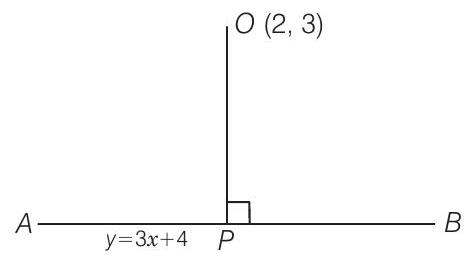
$\therefore$ Equation of line $O P$ is
$ \begin{matrix} & y-3 =-\frac{1}{3}(x-2) \\ \Rightarrow & 3 y-9 =-x+2 \\ \Rightarrow & x+3 y-11 =0 \end{matrix} $
Using the value of $y$ from Eq. (i) in Eq. (ii), we get
$ x+3(3 x+4)-11=0 $
$ \begin{matrix} \Rightarrow & x+9 x+12-11=0 \\ \Rightarrow & 10 x+1=0 \Rightarrow x=-\frac{1}{10} \end{matrix} $
Put $x=\frac{-1}{10}$ in Eq. (i), we get
$ y=\frac{-3}{10}+4=\frac{-3+40}{10}=\frac{37}{10} $
So, the foot of perpendicular is $\Big(-\frac{1}{10}, \frac{37}{10}\Big)$.
33. If the coordinates of the middle point of the portion of a line intercepted between the coordinate axes is $(3,2)$, then the equation of the line will be
(a) $2 x+3 y=12$
(b) $3 x+2 y=12$
(c) $4 x-3 y=6$
(d) $5 x-2 y=10$
Show Answer
Solution
(a) Since, the coordinates of the middle point are $P(3,2)$.
$ \begin{aligned} & \therefore \quad 3=\frac{1 \cdot 0+1 \cdot a}{1+1} \\ & \Rightarrow \quad 3=\frac{a}{2} \Rightarrow a=6 \\ & \text { Similarly, } \quad b=4 \\ & \therefore \quad \text { Equation of the line is } \frac{x}{6}+\frac{y}{4}=1 \\ & \Rightarrow \quad 2 x+3 y=12 \end{aligned} $
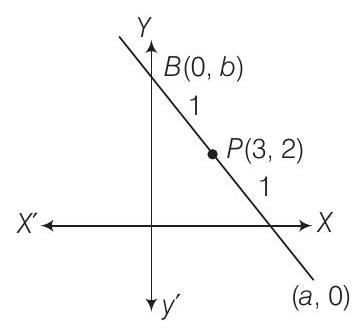
34. Equation of the line passing through $(1,2)$ and parallel to the line $y=3 x-1$ is
(a) $y+2=x+1$
(b) $y+2=3(x+1)$
(c) $y-2=3(x-1)$
(d) $y-2=x-1$
Show Answer
Solution
(c) Since, the line passes through $(1,2)$ and parallel to the line $y=3 x-1$. So, slope of the required line $m=3$. Hence, the equation of line is
$ y-2=3(x-1) $
35. Equations of diagonals of the square formed by the lines $x=0, y=0, x=1$ and $y=1$ are
(a) $y=x, y+x=1$
(b) $y=x, x+y=2$
(c) $2 y=x, y+x=\frac{1}{3}$
(d) $y=2 x, y+2 x=1$
Show Answer
Solution
(a) Equation of $O B$ is
$ y-0 =\frac{1-0}{1-0}(x-0) $
$ \Rightarrow y =x $
$ \text { and equation of } A C \text { is } $
$ \Rightarrow y-0 =\frac{1-0}{0-1}(x-1) $
$ \Rightarrow y+y-1 =0 $
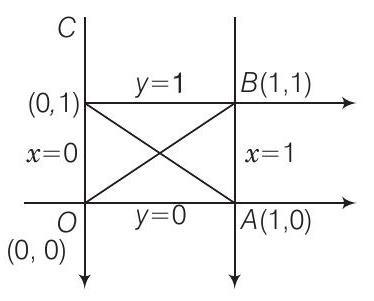
36. For specifying a straight line, how many geometrical parameters should be known?
(a) 1
(b) 2
(c) 4
(d) 3
Show Answer
Solution
(b) Equation of straight lines are
$ \begin{aligned} \qquad y & =m x+c, \text { parameter }=2 \\ \frac{x}{a}+\frac{y}{b} & =1, \text { parameter }=2 \\ y-y_1 & =m(x-x_1), \text { parameter }=2 \\ \text { and } \quad x \cos w & +y \sin w=p, \text { parameter }=2 \end{aligned} $
It is clear that from Eqs. (i), (ii), (iii) and (iv), for specifying a straight line clearly two parameters should be known.
37. The point $(4,1)$ undergoes the following two successive transformations
(i) Reflection about the line $y=x$
(ii) Translation through a distance 2 units along the positive $X$-axis.
Then, the final coordinates of the point are
(a) $(4,3)$
(b) $(3,4)$
(c) $(1,4)$
(d) $\frac{7}{2}, \frac{7}{2}$
Show Answer
Solution
(b) Let the reflection of $A(4,1)$ in $y=x$ is $B(h, k)$.
Now, mid-point of $A B$ is $\Big(\frac{4+h}{2}, \frac{1+k}{2}\Big)$ which lies on $y=x$.
i.e., $\quad \frac{4+h}{2}=\frac{1+k}{2} \Rightarrow h-k=-3$
So, the slope of line $y=x$ is 1 .
$ \text { Slope of } A B =\frac{h-4}{k-1} $
$ \Rightarrow 1 \cdot \frac{h-4}{k-1} =-1$
$ \Rightarrow h-4 =1-k $
$ \Rightarrow h+k =5 $
$ \text { and } 2 h =2 \Rightarrow h=1 $
On putting $h=1$ in Eq. (ii), we get
$ k=4 $
So, the point is $(1,4)$.
Hence, after translation the point is $(1+2,4)$ or $(3,4)$.
38. A point equidistant from the lines $4 x+3 y+10=0,5 x-12 y+26=0$ and $7 x+24 y-50=0$ is
(a) $(1,-1)$
(b) $(1,1)$
(c) $(0,0)$
(d) $(0,1)$
Show Answer
Solution
(c) The given equation of lines are
$ 4 x+3 y+10 =0 $
$ \Rightarrow 5 x-12 y+26 =0 $
$ \Rightarrow 7 x+24 y-50 =0 $
Let the point $(h, k)$ which is equidistant from these lines.
Distance from line (i) $=\frac{|4 h+3 k+10|}{\sqrt{16+9}}$
Distance from line (ii) $=\frac{|5 h-12 k+26|}{\sqrt{25+144}}$
Distance from the line (iii) $=\frac{|7 h+24 k-50|}{\sqrt{7^{2}+24^{2}}}$
So, the point $(h, k)$ is equidistant from lines (i), (ii) and (iii).
$ \begin{matrix} \therefore & \frac{4 h+3 k+10}{\sqrt{16+9}}=\frac{5 h-12 k+26}{\sqrt{25+144}}=\frac{7 h+24 k-50}{\sqrt{49+576}} \\ \\ \Rightarrow & \frac{|4 h+3 k+10|}{5}=\frac{|5 h-12 k+26|}{13}=\frac{|7 h+24 k-50|}{25} \end{matrix} $
Clearly, if $h=0, k=0$, then $\frac{10}{5}=\frac{26}{13}=\frac{50}{25}=2$
Hence, the required point is $(0,0)$.
39. A line passes through $(2,2)$ and is perpendicular to the line $3 x+y=3$. Its $y$-intercept is
(a) $\frac{1}{3}$
(b) $\frac{2}{3}$
(c) 1
(d) $\frac{4}{3}$
Show Answer
Thinking Process
First of all find the equation of required line using the formulae. i.e., $y-y_1=m(x-x_1)$ then put $x=0$ to get $y$-intercept.
Solution
(d) Given line is $y=3-3 x$.
Then, slope of the required line $=\frac{1}{3}$
$\because \quad$ Equation of the required line is
$ y-2 =\frac{1}{3}(x-2) $
$ \Rightarrow 3 y-6 =x-2 $
$ \Rightarrow x-3 y+4 =0 $
$ \text { For y-intercept, } \text { put } x =0, $
$ \Rightarrow 0-3 y+4 =0$
$ y =\frac{4}{3} $
40. The ratio in which the line $3 x+4 y+2=0$ divides the distance between the lines $3 x+4 y+5=0$ and $3 x+4 y-5=0$ is
(a) $1: 2$
(b) $3: 7$
(c) $2: 3$
(d) $2: 5$
Show Answer
Solution
(b) Let point $A(x_1, y_1)$ lies on the line $3 x+4 y+5=0$, then $3 x_1+4 y_1+5=0$
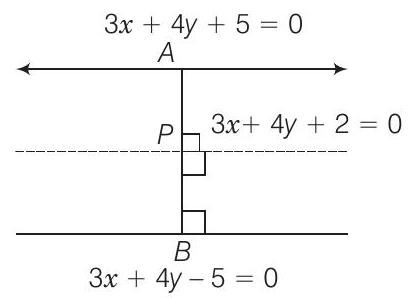
Now, perpendicular distance from $A$ to the line
$ \begin{aligned} 3 x+4 y+2 & =0 \\ \Rightarrow \quad & \frac{|3 x_1+4 y_1+2|}{\sqrt{9+16}}=\frac{|-5-2|}{\sqrt{9+16}}=\frac{-7}{5} \end{aligned} $
Let point $B(x_2, y_2)$ lies on the line $3 x+4 y-5=0$ i.e., $3 x_2+4 y_2-5=0$. Now, perpendicular distance from $B$ to the line $3 x+4 y+2=0$,
$ \frac{|3 x_2+4 y_2+2|}{\sqrt{9+16}}=\frac{|+5-2|}{\sqrt{9+16}}=\frac{3}{5} $
Hence, the required ratio is $\frac{3}{5}: \frac{7}{5}$ i.e., $3: 7$.
41. One vertex of the equilateral triangle with centroid at the origin and one side as $x+y-2=0$ is
(a) $(-1,-1)$
(b) $(2,2)$
(c) $(-2,-2)$
(d) $(2,-2)$
Show Answer
Thinking Process
Let $A B C$ be the equilateral triangle with vertex $A(h, k)$ and $D(\alpha, \beta)$ be the point on $B C$. Then, $\frac{2 \alpha+h}{3}=0=\frac{2 \beta+k}{3}$. Also, $\alpha+\beta-2=0$ and $\Big(\frac{k-0}{h-0}\Big) \cdot(-1)=-1$.
Solution
(c) Let $A B C$ be the equilateral triangle with vertex $A(h, k)$. Let the coordinates of $D$ are $(\alpha, \beta)$.
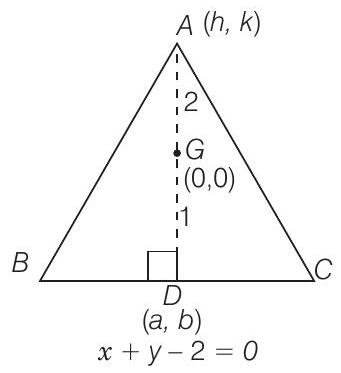
We know that, $2: 1$ from the vertex $A$.
$ \begin{matrix} \therefore & 0 =\frac{2 \alpha+h}{3} \text { and } 0=\frac{2 \beta+k}{3} \\ \\ \Rightarrow & 2 \alpha =-h \\ \\ \text { and } & 2 \beta =-k \\ \\ \text { Also, } D(\alpha, \beta) \text { lies on the line } & x+y-2=0 . \\ \\ \therefore & \alpha+\beta-2=0 \\ \\ & A D \perp B C \end{matrix} $
Since, the slope of line $B C$ i.e., $m_{B C}=-1$
and slope of the line $A G$ i.e., $m_{A G}=\frac{k-0}{h-0}=\frac{k}{h}$
$ \begin{aligned} \Rightarrow & (-1) \cdot \Big(\frac{k}{h}\Big) & =-1 \\ \Rightarrow & h =k \end{aligned} $
From Eqs. (i) and (iii),
$ \begin{aligned} & \qquad \begin{aligned} 2 \alpha & =-h \text { and } 2 \beta=-h \\ \therefore & \alpha=\beta \end{aligned} \\ & \text { From Eq. (ii), } \\ & \text { If } \alpha=1 \text {, then } \beta=1 \\ & \text { From Eq. (i), } h=-2, k=-2 \\ & \text { So, the vertex } A \text { is }(-2,-2) . \end{aligned} $
Fillers
42. If $a, b$ and $c$ are in AP, then the straight lines $a x+b y+c=0$ will always pass through ……
Show Answer
Thinking Process
If $a, b$ and $c$ are in AP, then $2 b=a+c$. Use this property to solve the above problem.
Solution
Given line is
$ a x+b y+c=0 $
Since, $a, b$ and $c$ are in AP, then
$ b=\frac{a+c}{2} $
$ \Rightarrow \quad a-2 b+c=0 $
On comparing Eqs. (i) and (ii), we get
$ x=1, y=2 $
So, $(1,-2)$ lies on the line.
43. The line which cuts off equal intercept from the axes and pass through the point $(1,-2)$ is ……
Show Answer
Solution
Let equation of line is
$ \frac{x}{a}+\frac{y}{a}=1 $
Since, this line passes through $(1,-2)$.
$ \Rightarrow \quad \begin{aligned} \frac{1}{a}-\frac{2}{a} & =1 \\ 1-2 & =a \Rightarrow a=-1 \end{aligned} $
$\therefore$ Required equation of the line is
$ -x-y=1 $
$ \Rightarrow \quad x+y+1=0 $
44. Equation of the line through thes point $(3,2)$ and making an angle of $45^{\circ}$ with the line $x-2 y=3$ are ……
Show Answer
Solution
Since, the given point $P(3,2)$ and line is $x-2 y=3$.
Slope of this line is $m_1=\frac{1}{2}$
Let the slope of the required line is $m$.
$ \begin{matrix} \text { Then, } & \tan \theta=\Big|\frac{m-\frac{1}{2}}{1+\frac{1}{2} m}\Big| \\ \\ \Rightarrow & 1= \pm \Big(\frac{m-\frac{1}{2}}{1+\frac{m}{2}}\Big) \end{matrix} $
Taking positive sign,
$ 1+\frac{m}{2}=m-\frac{1}{2} $
$ \begin{aligned} \Rightarrow m-\frac{m}{2} & =1+\frac{1}{2} \\ \Rightarrow\frac{m}{2} & =\frac{3}{2} \Rightarrow m=3 \end{aligned} $
Taking negative sign,
$ \begin{aligned} & & 1=-\Big(\frac{m-\frac{1}{2}}{1+\frac{m}{2}}\Big) \\ \Rightarrow & 1+\frac{m}{2} =-m+\frac{1}{2} \\ \Rightarrow & m+\frac{m}{2} =\frac{1}{2}-1 \\ \Rightarrow & \frac{3 m}{2} =\frac{-1}{2} \Rightarrow m=\frac{-1}{3} \end{aligned} $
$\therefore \quad$ First equation of the line is
$ y-2 =3(x-3) $
$ 3 x-y-7 =0 $
and second equation of the line is
$ \begin{matrix} y-2 & =-\frac{1}{3}(x-3) \\ \Rightarrow & 3 y-6 & =-x+3 \\ \Rightarrow & x+3 y-9 & =0 \end{matrix} $
45. The points $(3,4)$ and $(2,-6)$ are situated on the …… of the line $3 x-4 y-8=0$.
Show Answer
Solution
$ \begin{gathered} \text{Given line is}\quad 3 x-4 y-8=0 \\ \text{For point (3,4),\quad}9-4 \cdot 4-8 \\ \Rightarrow 9-16-8 \\ \Rightarrow 9-24 \\ \Rightarrow -15<0 \end{gathered} $
For point $(2,-6)$,
$ \begin{aligned} & 6+24-8 \\ & 22>0 \end{aligned} $
Since, the value are of opposite sign.
Hence, the points $(3,4)$ and $(2,-6)$ lies on opposite side to the line.
46. A point moves so that square of its distance from the point $(3,-2)$ is numerically equal to its distance from the line $5 x-12 y=3$. The equation of its locus is ……
Show Answer
Solution
Let the coordinaters of the point are $(h, k)$,
$\therefore \quad$ Distance between $(3,-2)$ and $(h, k)$,
$ d_1^{2}=(3-h)^{2}+(-2-k)^{2} $
Now, distance of the point $(h, k)$ from the line $5 x-12 y=3$ is,
$ d_2=\Big|\frac{5 h-12 k-3}{\sqrt{25+144}}\Big|=\Big|\frac{5 h-12 k-3}{13}\Big| $
Given that, $ d_1^{2}=d_2 $
$ \begin{aligned} & \Rightarrow \quad(3-h)^{2}+(2+k)^{2}=\frac{5 h-12 k-3}{13} \\ & \Rightarrow \quad 9-6 h+h^{2}+4+4 k+k^{2}=\frac{5 h-12 k-3}{13} \\ & \Rightarrow \quad h^{2}+k^{2}-6 h+4 k+13=\frac{5 h-12 k-3}{13} \\ & \Rightarrow \quad 13 h^{2}+13 k^{2}-78 h+52 k+169=5 h-12 k-3 \\ & \Rightarrow \quad 13 h^{2}+13 k^{2}-83 h+64 k+172=0 \end{aligned} $
$\therefore$ Locus of this point is
$ \quad 13 x^{2}+13 y^{2}-83 x+64 y+172=0 $
47. Locus of the mid-points of the portion of the line $x \sin \theta+y \cos \theta=p$ intercepted between the axes is ……
Show Answer
Solution
Given equation of the line is
$ x \sin \theta+y \cos \theta=p $
Let the mid-point of $A B$ is $p(h, k)$.
So, the mid-point of $A B$ are
$ \quad\Big(\frac{a}{2}, \frac{b}{2}\Big) $
Since, the point $(a, 0)$ lies on the line (i), then
$ a \sin \theta+0=p $
$ \Rightarrow \quad a \sin \theta=p \Rightarrow a=\frac{p}{\sin \theta} $
and the point $(0, b)$ also lies on the line, then
$0+b\cos \theta=p$
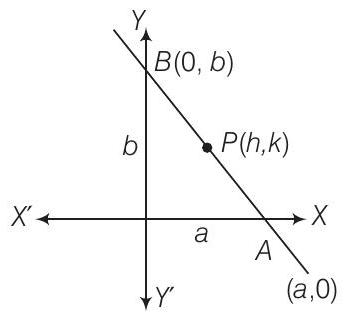
$ \Rightarrow \quad b \cos \theta=p \Rightarrow b=\frac{p}{\cos \theta} $
Now $ \text { mid-point of } A B=\Big(\frac{a}{2}, \frac{b}{2}\Big) \text { or } \Big(\frac{p}{2 \sin \theta}, \frac{p}{2 \cos \theta}\Big) $
$\because$ $ \frac{p}{2 \sin \theta}=h \Rightarrow \sin \theta=\frac{p}{2 h} $
and
$ \frac{p}{2 \cos \theta}=k \Rightarrow \cos \theta=\frac{p}{2 k} $
$\therefore \quad \sin ^{2} \theta+\cos ^{2} \theta=\frac{p^{2}}{4 h^{2}}+\frac{p^{2}}{4 k^{2}}$
$ \Rightarrow \quad 1=\frac{p^{2}}{4}\Big( \frac{1}{h^{2}}+\frac{1}{k^{2}}\Big) $
Locus of the mid-point is
$ \begin{aligned} 4 & =p^{2} \Big(\frac{1}{x^{2}}+\frac{1}{y^{2}}\Big) \\ \Rightarrow \quad 4 x^{2} y^{2} & =p^{2}\Big(x^{2}+y^{2}\Big) \end{aligned} $
True/False
48. If the vertices of a triangle have integral coordinates, then the triangle cannot be equilateral.
Show Answer
Solution
True
We know that, if the vertices of a triangle have integral coordinates, then the triangle cannot be equilateral. Hence, the given statement is true.
Since, in equilatteral triangle, we get $\tan 60^{\circ}=\sqrt{3}=$ Slope of the line, so with integral coordinates as vertices, the triangle cannot be equilateral.
49. The points $A(-2,1), B(0,5)$ and $C(-1,2)$ are collinear.
Show Answer
Solution
False
Given points are $A(-2,1), B(0,5)$ and $C(1,2)$.
Now, $ \text { slope of } A B=\frac{5-1}{0+2}=2 $
Slope of
$ \begin{aligned} & B C=\frac{2-5}{-1-0}=3 \\ & A C=\frac{2-1}{-1+2}=1 \end{aligned} $
Slope of
Since, the slopes are different.
Hence, $A, B$ and $C$ are not collinear. So, statement is false.
50. Equation of the line passing through the point $(a \cos ^{3} \theta, a \sin ^{3} \theta)$ and perpendicular to the line $x \sec \theta+y cosec \theta=a$ is $x \cos \theta-y \sin \theta=a \sin 2 \theta$.
Show Answer
Solution
False
Given point $p(a \cos ^{3} \theta, a \sin ^{3} \theta)$ and the line is $x \sec \theta+y cosec \theta=a$
$\because \quad$ Slope of this line $=\frac{-\sec \theta}{cosec \theta}=-\tan \theta$
and
$ \text { slope of required line }=\frac{1}{\tan \theta}=\cot \theta $
$\therefore \quad$ Equation of the required line is
$ \begin{matrix} \Rightarrow & y-a \sin ^{3} \theta=\cot \theta(x-a \cos ^{3} \theta) \\ \Rightarrow & y \sin \theta-a \sin ^{4} \theta=x \cos \theta-acos^{4} \theta \\ \Rightarrow & x \cos \theta-y \sin \theta=a \cos ^{4} \theta-asin^{4} \theta \\ \Rightarrow & x \cos \theta-y \sin \theta=a[(\cos ^{2} \theta+\sin ^{2} \theta)(\cos ^{2} \theta-\sin ^{2} \theta)] \\ \Rightarrow & x \cos \theta-y \sin \theta=a \cos ^{2} \theta \end{matrix} $
Hence, the given statement is false.
51. The straight line $5 x+4 y=0$ passes through the point of intersection of the straight lines $x+2 y-10=0$ and $2 x+y+5=0$.
Show Answer
Solution
True
$\begin{matrix} \text { Given that, } & \\ \begin{aligned} & x+2 y-10=0 \\ & \text { and }\end{aligned} \\ 2 x+y+5 =0\end{matrix} $
From Eq. (i), put the value of $x=10-2 y$ in Eq. (ii), we get
$ \begin{aligned} \Rightarrow & 20-4 y+y+5 =0 \\ \Rightarrow & 20-3 y+5 =0 \\ \therefore & x+\frac{50}{3}-10 =0 \\ \Rightarrow & x+\frac{20}{3}=0 \Rightarrow x =\frac{-20}{3} \end{aligned} $
So, the point of intersection is $\Big(-\frac{20}{3}, \frac{25}{3}\Big)$.
If the line $5 x+4 y=0$ passes through the point $\Big(-\frac{20}{3}, \frac{25}{3}\Big)$, then this point should lie on this line.
$ \because \quad 5 \frac{-20}{3}+\frac{4(25)}{3}=\frac{-100}{3}+\frac{100}{3}=0 $
So, this point lies on the given line.
Hence, the statement is true.
52. The vertex of an equilateral triangle is $(2,3)$ and the equation of the opposite side is $x+y=2$. Then, the other two sides are $y-3=(2 \pm \sqrt{3})(x-2)$.
Show Answer
Solution
True
Let $A B C$ be an equilateral triangle with vertex $A(2,3)$, and equation of $B C$ is $x+y=2$. i.e., slope $=-1$.
Let slope of line $A B$ is $m$.
Since, the angle between line $A B$ and $B C$ is $60^{\circ}$.
$ \begin{aligned} & \therefore \quad \tan 60^{\circ}=\Big|\frac{m+1}{1-m} \Big|\\ & \Rightarrow \quad \sqrt{3}= \pm \Big(\frac{m+1}{1-m}\Big) \quad \text { [taking positive sign] } \\ & \Rightarrow \quad \sqrt{3}-\sqrt{3} m=m+1 \\ & \Rightarrow \quad \sqrt{3}-1=m+\sqrt{3} m \\ & \Rightarrow \quad \sqrt{3}-1=m(1+\sqrt{3}) \\ & \therefore \quad m=\frac{(\sqrt{3}-1)(\sqrt{3}-1)}{(\sqrt{3}+1)(\sqrt{3}-1)} \\ & =\frac{3+1-2 \sqrt{3}}{3-1}=\frac{4-2 \sqrt{3}}{2}=2-\sqrt{3} \end{aligned} $
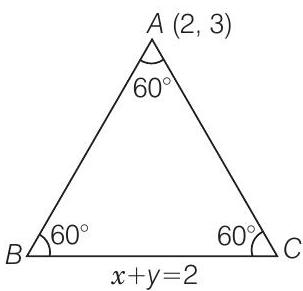
Similarly, slope of $A B=2+\sqrt{3}$
$\therefore$ Equation of other two side is
[taking negative sign]
$ y-3=(2 \pm \sqrt{3})(x-2) $
Hence, the statement is true.
53. The equation of the line joining the point $(3,5)$ to the point of intersection of the lines $4 x+y-1=0$ and $7 x-3 y-35=0$ is equidistant from the points $(0,0)$ and $(8,34)$.
Show Answer
Thinking Process
Equation of a line passing through the points $(x_1, y_1)$ and $(x_2, y_2)$ is
$y-y_1=\frac{y_2-y_1}{x_2-x_1}(x-x_1)$
Solution
True
Given equation of lines are $4x+y-1=0$
$ \text { and } \quad 7 x-3 y-35=0 $
From Eq. (i), on putting $y=1-4 x$ in Eq. (ii), we get
$ 7 x-3+12 x-35=0 $
$ \Rightarrow \quad 19 x-38=0 \Rightarrow x=2 $
On putting $x=2$ in Eq. (i), we get
$ 8+y-1=0 \Rightarrow y=-7 $
Now, the equation of a line passing through $(3,5)$ and $(2,-7)$ is
$ \begin{aligned} y-5 =\frac{-7-5}{2-3}(x-3) \\ \Rightarrow y-5 =12(x-3) \\ \Rightarrow 12 x-y-31 =0 \end{aligned} $
Distance from $(0,0)$ to the line (iii),
$ d_1=\frac{|-31|}{\sqrt{144+1}}=\frac{31}{\sqrt{145}} $
$\therefore$ Distance from $(8,34)$ to the line (iii),
$ \begin{aligned} d_2 & =\frac{|96-34-31|}{\sqrt{145}}=\frac{31}{\sqrt{145}} \\ \because \quad d_1 & =d_2 \end{aligned} $
Hence, the statement is true.
54. The line $\frac{x}{a}+\frac{y}{b}=1$ moves in such a way that $\frac{1}{a^{2}}+\frac{1}{b^{2}}=\frac{1}{c^{2}}$, where $c$ is a constant. The locus of the foot of the perpendicular from the origin on the given line is $x^{2}+y^{2}=c^{2}$.
Show Answer
Solution
True
Given that, equation of line is
$ \frac{x}{a}+\frac{y}{b}=1 $
Equation of line passing through origin and perpendicular to line (i) is
$ \frac{x}{b}-\frac{y}{a}=0 $
Now, foot of perpendicular is the point of intersection of lines (i) and (ii). To find its locus we have to eliminate the variable $a$ and $b$.
On squaring and adding Eqs. (i) and (ii), we get
$ \begin{matrix} \Rightarrow & \frac{x^{2}}{a^{2}}+\frac{y^{2}}{b^{2}}+\frac{2 x y}{a b}+\frac{x^{2}}{b^{2}}+\frac{y^{2}}{a^{2}}-\frac{2 x y}{a b} =1 \\ \\ \Rightarrow & x^{2} \Big(\frac{1}{a^{2}}+\frac{1}{b^{2}}\Big)+y^{2} \Big(\frac{1}{a^{2}}+\frac{1}{b^{2}}\Big) =1 \\ \\ \Rightarrow \frac{x^{2}}{c^{2}}+\frac{y^{2}}{c^{2}} =1 \\ \\ x^{2}+y^{2} =c^{2} & [\because \frac{1}{a^{2}}+\frac{1}{b^{2}}=\frac{1}{c^{2}}] \end{matrix} $
Hence, the statement is true.
55. The lines $a x+2 y+1=0, \quad b x+3 y+1=0$ and $c x+4 y+1=0$ are concurrent, if $a, b$ and $c$ are in GP.
Show Answer
Thinking Process
First of all find the intersection point of first two line. Then, if the lines are concurrent then this point should lies on the third line.
Solution
False
Given lines are
and $\quad \begin{aligned} & a x+2 y+1=0 \\ & b x+3 y+1=0\end{aligned}$
From Eq. (i), on putting $y=\frac{-a x-1}{2}$ in Eq. (ii), we get
$ b x-\frac{3}{2}(a x+1)+1=0 $
$ \Rightarrow 2 b x-3 a x-3+2=0 $
$ \Rightarrow x(2 b-3 a)=1 \Rightarrow x=\frac{1}{2 b-3 a} $
Now, using $x=\frac{1}{2 b-3 a}$ in Eq. (i), we get
$ \frac{a}{2 b-3 a}+2 y+1 =0 $
$ \Rightarrow 2 y =-\Big[\frac{a+2 b-3 a}{2 b-3 a}\Big] $
$ \Rightarrow 2 y =\frac{-(2 b-2 a)}{2 b-3 a} $
$ \Rightarrow y =\frac{(a-b)}{2 b-3 a} $
So, the point of intersection is $\Big(\frac{1}{2 b-3 a}, \frac{a-b}{2 b-3 a}\Big)$.
Since, this point lies on $c x+4 y+1=0$, then
$ \frac{c}{2 b-3 a}+\frac{4(a-b)}{2 b-3 a}+1=0 $
$ \Rightarrow c+4 a-4 b+2 b-3 a=0 $
$ \Rightarrow -2 b+a+c=0 \Rightarrow 2 b=a+c $
Hence, the given statement is false.
56. Line joining the points $(3,-4)$ and $(-2,6)$ is perpendicular to the line joining the points $(-3,6)$ and $(9,-18)$.
Show Answer
Solution
False
Given points are $A(3,-4), B(-2,6), P(-3,6)$ and $Q(9,-18)$.
Now $ \begin{aligned} & \text { slope of } A B=\frac{6+4}{-2-3}=-2 \\ & \text { slope of } P Q=\frac{-18-6}{9+3}=-2 \end{aligned} $
and
So, line $A B$ is parallel to line $P Q$.
Matching the Columns
57. Match the following.
| Column I | Column II |
|---|---|
| (i)The coordinates of the points $P$ and $Q$ on the line $x+5 y=13$ which are at a distance of 2 units from the line $12 x-5 y+26=0$ are |
(a) $\quad(3,1),(-7,11)$ |
| (ii)The coordinates of the point on the line $x+y=4$, which are at a unit distance from the line $4 x+3 y-10=0$ are |
(b) $\Big(-\frac{1}{3}, \frac{11}{3}\Big), \Big(\frac{4}{3}, \frac{7}{3}\Big)$ |
| (iii)The coordinates of the point on the line joining $A(-2,5)$ and $B(3,1)$ such that $A P=P Q=Q B$ are |
(c) $\Big(1, \frac{12}{5}\Big),\Big(-3, \frac{16}{5}\Big)$ |
Show Answer
Solution
(i) Let the coordinate of point $P(x_1, y_1)$ on the line $x+5 y=13 i$.e.,
$ P(13-5 y_1, y_1) $
$\therefore$ Distance of $P$ from the line $12 x-5 y+26=0$,
$ \begin{aligned} & \qquad 2=\Big|\frac{12(13-5 y_1)-5 y_1+26}{\sqrt{144+25}}\Big| \\ & \Rightarrow \quad 2= \pm \frac{156-60 y_1-5 y_1+26}{13} \\ & \Rightarrow \quad-65 y_1=-156 \quad \text { [taking positive sign] } \\ & \begin{aligned} y_1 & =\frac{156}{65}=\frac{12}{5} \\ x_1 & =13-5 y_1 \\ & =13-12=1 \end{aligned} \\ & \text { So, the coordinate of is } P \begin{aligned} & \Big(1, \frac{12}{5}\Big) . \end{aligned} \\ & \text { Similarly, the coordinates of } Q \text { are }\Big(-3, \frac{16}{5}\Big) . \end{aligned} $
(ii) Let coordinates of the point on the line $x+y=4$ be $(4-y_1, y_1)$. Distance from the line $4 x+3 y-10=0$.
$ 1=\Big|\frac{4(4-y_1)+3 y_1-10}{\sqrt{16+9}}\Big| $
$ \Rightarrow 1= \pm \frac{16-4 y_1+3 y_1-10}{5} $
$ \Rightarrow 5=6-y_1 $
$ \Rightarrow y_1=1 $
$ \text { If } y_1=1 \text {, then } x_1=3 $
So, the point is $(3,1)$.
Similarly, taking negative sign the point is $(-7,11)$.
(iii) Given point $A(-2,5)$ and $B(3,1)$.

Now, the point $P$ divides line joining the point $A$ and $B$ in $1: 2$.
$ \begin{matrix} \because & x_1=\frac{1 \cdot 3+2(-2)}{1+2}=\frac{3-4}{3}=\frac{-1}{3} \\ \\ \text { and } & y_1=\frac{1 \cdot 1+2 \cdot 5}{1+2}=\frac{11}{3} \end{matrix} $
So, the coordinates of $P$ are $\Big(\frac{-1}{3}, \frac{11}{3}\Big)$
Thus, the point $Q$ divided the line joining $A$ to $B$ in $2: 1$.
$ \begin{matrix} \because & x_2=\frac{2 \cdot 3+1(-2)}{2+1}=\frac{4}{3} \\ \\ \text { and } & y_2=\frac{2 \cdot 1+1 \cdot 5}{2+1}=\frac{7}{3} \end{matrix} $
Hence, the coordinates of $Q$ are $\Big(\frac{4}{3}, \frac{7}{3}\Big)$.
Hence, the correct matches are (i) $\rightarrow$ (c), (ii) $\rightarrow$ (a), (iii) $\rightarrow$ (b).
58. The value of the $\lambda$, if the lines $(2+3 y+4)+\lambda(6 x-y+12)=0$ are
| Column I | Column II |
|---|---|
| (i) parallel to $Y$-axis is | (a) $\quad \lambda=-\frac{3}{4}$ |
| (ii) perpendicular to $7 x+y-4=0$ is | (b) $\quad \lambda=-\frac{1}{3}$ |
| (iii) passes through $(1,2)$ is | (c) $\quad \lambda=-\frac{17}{41}$ |
| (iv) parallel to $X$-axis is | (d) $\quad \lambda=3$ |
Show Answer
Solution
(i) Given equation of the line is
$ (2 x+3 y+4)+\lambda(6 x-y+12)=0 $
If line is parallel to $Y$-axis i.e., it is perpendicular to $X$-axis
$ \therefore \quad \text { Slope }=m=\tan 90^{\circ}=\infty $
$\begin{aligned} & \text { From line (i), } x(2+6 \lambda)+y(3-\lambda)+4+12 \lambda=0 \\ & \text { and slope } \\ & =\frac{-(2+6 \lambda)}{3-\lambda} \\ & \Rightarrow \quad \frac{-2-6 \lambda}{3-\lambda}=\infty \\ & \Rightarrow \quad \frac{-2-6 \lambda}{3-\lambda}=\frac{1}{0} \Rightarrow \lambda=3 \\ & \end{aligned}$
(ii) If the line (i) is perpendicular to the line $7 x+y-4=0$ or $y=-7 x+4$
$ \begin{matrix} \because & \frac{-(2+6 \lambda)}{(3-\lambda)}(-7) & =-1 \\ \Rightarrow & 14+42 \lambda =-3+\lambda \\ \Rightarrow & 41 \lambda =-17 \\ \Rightarrow & \lambda =-\frac{17}{41} \end{matrix} $
(iii) If the line (i) passes through the point $(1,2)$.
$ \begin{matrix} \text { Then, } & (2+6+4)+\lambda(6-2+12) =0 \\ \Rightarrow & 12+16 \lambda=0 \Rightarrow \lambda =-\frac{3}{4} \end{matrix} $
(iv) If the line is parallel to $X$-axis the slope $=0$.
$ \begin{matrix} \text { Then, } & \frac{-(2+6 \lambda)}{3-\lambda}=0 \\ \\ \Rightarrow & -(2+6 \lambda)=0 \Rightarrow \lambda=-\frac{1}{3} \end{matrix} $
So, the correct matches are (i) $\rightarrow$ (d), (ii) $\rightarrow$ (c), (iii) $\rightarrow$ (a), (iv) $\rightarrow$ (b).
59. The equation of the line through the intersection of the lines $2 x-3 y=0$ and $4 x-5 y=2$ and
| Column I | Column II |
|---|---|
| (i) through the point $(2,1)$ is | (a) $2 x-y=4$ |
| (ii) perpendicular to the line $x+2 y+1=0$ | (b) $x+y-5=0$ |
| (iii) parallel to the line $3 x-4 y+5=0$ is | (c) $x-y-1=0$ |
| (iv) equally inclined to the axes is | (d) $3 x-4 y-1=0$ |
Show Answer
Solution
Given equation of the lines are
$ 2 x-3 y =0 $
and $\quad$
$ 4 x-5 y =2 $
From Eq. (i), put $x=\frac{3 y}{2}$ in Eq. (ii), we get
$\Rightarrow$ $ 4 \cdot \frac{(3 y)}{2}-5 y=2 $
$\Rightarrow$ $ 6 y-5 y=2 $
Now, put $y=2$ in Eq. (i), we get
$ y=2 $
So, the intersection points are $(3,2)$.
$ x=3 $
(i) The equation of the line passes through the point $(3,2)$ and $(2,1)$, is
$ y-2 =\frac{1-2}{2-3}(x-3) $
$ \Rightarrow y-y-1 =0 $
$ \Rightarrow x-2 =(x-3) $
(ii) If the required line is perpendicular to the line $x+2 y+1=0$
$\because$ Slope of the required line $=2$
$\therefore$ Equation of the line is
$ y-2 =2(x-3) $
$ \Rightarrow 2 x-y-4 =0 $
(iii) If the required line is parallel to the line $3 x-4 y+5=0$, then the slope of the required line $=\frac{3}{4}$
$\therefore$ Equation of the required line is
$ y-2=\frac{3}{4}(x-3) $
$ \Rightarrow 4 y-8=3 x-9 $
$ \Rightarrow 3 x-4 y-1=0 $
(iv) If the line is equally inclined to the $X$-axis, then
$ m= \pm \tan 45^{\circ}= \pm 1 $
$\therefore$ Equation of the line is
| $y-2$ | $=-1(x-3)$ | ||
|---|---|---|---|
| $\Rightarrow$ | $y-2$ | $=-x+3$ | |
| $\Rightarrow$ | $x+y-5$ | $=0$ | |
| So, the correct matches are (a) $\rightarrow$ (iii), (b) $\rightarrow$ (i), (c) $\rightarrow$ (iv), (d) $\rightarrow$ (ii). |










